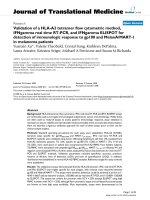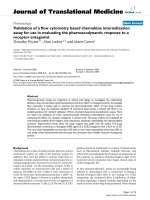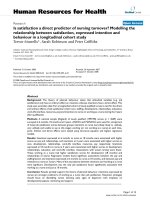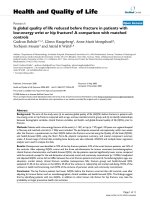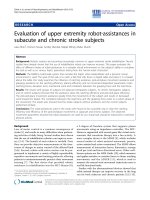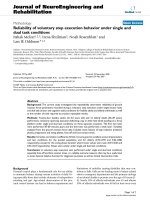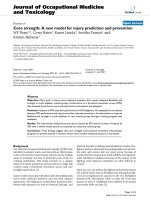báo cáo hóa học:" Is there a relationship between factor V Leiden and type 2 diabetes?" doc
Bạn đang xem bản rút gọn của tài liệu. Xem và tải ngay bản đầy đủ của tài liệu tại đây (179.48 KB, 4 trang )
BioMed Central
Page 1 of 4
(page number not for citation purposes)
Journal of Translational Medicine
Open Access
Research
Is there a relationship between factor V Leiden and type 2 diabetes?
Corrado Lodigiani*
1
, Paola Ferrazzi
1,2
, Pierpaolo Di Micco
1,3
, Luca Librè
1
,
Stefano Genovese
4
, Ilaria Quaglia
1
and Lidia Luciana Rota
1
Address:
1
Thrombosis Center, Istituto Clinico Humanitas IRCCS, Rozzano (MI), Italy,
2
Unit of Laboratory and Clinical Chemistry, Istituto Clinico
Humanitas IRCCS, Rozzano (MI), Italy,
3
Internal Medicine, Fatebenefratelli Hospital of Naples, Italy and
4
Endocrine and Diabetes Unit, Istituto
Clinico Humanitas IRCCS, Rozzano (MI), Italy
Email: Corrado Lodigiani* - ; Paola Ferrazzi - ; Pierpaolo Di
Micco - ; Luca Librè - ; Stefano Genovese - ;
Ilaria Quaglia - ; Lidia Luciana Rota -
* Corresponding author
Abstract
Background: Diabetes is well known risk factor for thrombotic events. The association between
diabetes and venous thromboembolism is still matter of debate. However, during diabetes an
acquired thrombophilia is present and is due to the non-enzymatic glycosilation of clotting
inhibitors as antithrombin thus leading to hypercoagulable state. A possibile relationship between
the presence of FVL gene variant in type 1 or type 2 diabetes has been hypothysed by several
reports in the Literature with non-univocal findings.
Patients and methods: Retrospectively we analysed nearly 7000 patients referred to our
Thrombosis Center for venous thromboembolism (VTE) then we selected 115 patients underwent
to the screening for inherited thrombophilia. All selected patients were divided in 2 groups: the
first group (group A) included 64 patients with previous VTE and carriers of factor V Leiden, while
the second group (group B) included 51 patients with previous VTE and evetually carriers of
thrombophilic defects other than factor V Leiden. Patients of group B acted as control group. 75 g
oral glucose tolerance Test (OGTT) recommended by WHO was perfomed to all subjects in the
study in order to screen subjects with glucose reduced tolerance or subjects with inducible
diabetes. Statistical analysis was performed with STATA 6
with Student t test
for unpaired data, with χ
2
test or with Fisher exact test where appropriated; differences were
considered to be significant if p < 0.05.
Results: We did not find sifferences between glycaemia at baseline and after OGTT between
patients with VTE carriers of FVL compared to non-carriers of FVL. We found a relevant increase
in the prevalence of IGT and diabetes between patients with VTE carriers of FVL compared to non-
carriers of FVL although this increase did not raise statistical significance.
Discussion: our data pointed out an interesting aspect of the linking between FVL gene variant,
diabetes and atherothrombosis and other vascular complications, although data on larger
population are needed; this aspect may be another relevant topic of research based because also a
link between the pathogenesis of venous thrombosis and atherothrombosis has been recently
reported in the Literature.
Published: 26 June 2009
Journal of Translational Medicine 2009, 7:52 doi:10.1186/1479-5876-7-52
Received: 19 March 2009
Accepted: 26 June 2009
This article is available from: />© 2009 Lodigiani et al; licensee BioMed Central Ltd.
This is an Open Access article distributed under the terms of the Creative Commons Attribution License ( />),
which permits unrestricted use, distribution, and reproduction in any medium, provided the original work is properly cited.
Journal of Translational Medicine 2009, 7:52 />Page 2 of 4
(page number not for citation purposes)
Background
Diabetes is well known risk factor for thrombotic events
[1]. In particular, since Framingham Study has been pub-
lished diabetes is recognised as one of the more common
risk factor for atherothrombosis [2]. Both type 1 diabetes
(i.e. insulin dependent) and type 2 diabetes (i.e. not-insu-
lin dependent) are associated to vascular events, in partic-
ular if glycated haemoglobin is higher than 7.0% [3].
Actually, in fact, vascular complications of diabetes repre-
sent the more common cause of morbidity and mortality
of diabetic patients [4,5]. On the other sides the associa-
tion between diabetes and venous thromboembolism
(VTE) is still matter of debate [6,7]. Some Author did not
find an association between diabetes and VTE [6], but
recently several Authors showed that atherosclerosis and
traditional atherosclerotic risk factor as diabetes should be
considered also as risk factor for VTE, in particular for idi-
opathic VTE [8].
Of course, during diabetes an acquired hypercoagulability
is present and is due to several factors as to the non-enzy-
matic glycosilation of clotting inhibitors as antithrombin
thus leading to hypercoagulable state [9,10]. This
acquired thrombophilia may be added in any case to a
possible inherited thrombophilia if such patients is carrier
of such thrombophilic gene variant (e.g. A1691G of factor
V and\or prothrombin A20210G) or other thrombotic
risk factor.
Factor V Leiden (FVL) is a well known inherited throm-
bophilic condition both in heterozygosity or in homozy-
gosity. The association between FVL and VTE has been
frequently described [11], while the association between
FVL and atherothrombosis is still matter of discussion in
particular for patients with early onset of vascular athero-
thrombosis [12,13].
A possibile relationship between the presence of FVL gene
variant and type 1 or type 2 diabetes has been hypothysed
by several reports in the Literature with non-univocal
findings [14-16].
The aim of our retropspective study is to find a possible
association between factor V Leiden gene variant and type
2 diabetes in a population of patients with previous VTE.
Patients and methods
We performed a retrospective analysis of nearly 7000
patients referred to our Thrombosis Center for one or
more episode of thrombotic disorders. After a first screen-
ing we analysed only patients with previous VTE and in
this population, we selected subjects that perfomed the
screening for inherited thrombophilia after one or more
episodes of VTE; so, we selected 115 patients underwent
to the screening for inherited thrombophilia.
Inclusion criteria
All selected patients were divided in 2 groups: the first
group (group A) included 64 patients (33 males and 31
females, mean age 54 ± 9 years) with previous VTE and
carriers of factor V Leiden as inherited thrombophilic
defect, while the second group (group B) included 51
patients (26 males and 25 females, mean age 51 ± 9 years)
with previous VTE and carriers of thrombophilic defects
other than factor V Leiden. Patients of group B acted as
control group.
Exclusion criteria
We excluded all patients affected by thrombotic disorders
other than VTE, and younger than 40 years and with
already personal history of diabetes.
Factor V Leiden identification
Whole blood samples were collected by venipuncture in
order to screen the presence of factor V Leiden gene vari-
ant.
DNA was extracted using an automated procedure
(MagNA PURE, Roche, Italy). Patients were screened for
the G1691A gene variant of factor V Leiden using PCR
amplification with specific primers and Light Cycler appa-
ratus (Roche, Milan, Italy).
Latent diabetes or reduced glucose intolerance
identification
75 g oral glucose tolerance Test (OGTT) recommended by
WHO was perfomed to all subjects in the study. According
to the WHO and National Diabetes Data Group (NDDG)
guidelines, we diagnosed diabetes if glycaemia after 2 hours
from OGTT was higher than 199 mg\dL and reduced glu-
cose tolerance, if glycaemia after 2 hours from OGTT was
higher than 139 mg\dL but lower than 199 mg/dl
Table 1: Glycaemic parameters in subjects with VTE and with or without FVL
Parameters Patients with VTE and FVL Patients with VTE without FVL p
Glycaemia at baseline (mg\dl) 93.55 ± 13.57 91.44 ± 13.19 0.68, ns
OGTT (mg\dl) 104.90 ± 30.04 101.38 ± 37.05 0.47, ns
VTE: venous thromboembolism; FVL: factor V Leiden; OGTT: oral glucose tolerance test
ns: not significant
Journal of Translational Medicine 2009, 7:52 />Page 3 of 4
(page number not for citation purposes)
Statistical analysis
Data are expressed as mean ± standard deviation (SD) or
as number and percentage where appropriated. Statistical
analysis was performed with STATA 6 http://
www.stata.com with Student t test for unpaired data or
with χ
2
test or with Fisher exact test where appropriated;
differences were considered to be significant if p < 0.05.
Results
We did not find significant difference between glycaemia
at baseline and two hours after OGTT between subjects
with VTE and FVL compared to control group [93.55 ±
13.57 mg\dl vs 91.44 ± 13.19 mg\dl (p: 0.68, not signifi-
cant) and 104.90 ± 30.04 mg\dl vs 101.38 ± 37.05 mg\dl
respectively; (p 0.47, not significant)] (table 1).
We found a significant increase of subjects with impaired
glucose tolerance in the group A (i.e. patients with previ-
ous VTE and carriers of FVL gene variant) compared to
controls, although this data did not raise statistical signif-
icance (5 patients, 7.81% vs 2 patients, 3.92%, p 0.07, not
significant) (table 2).
Similarly we found an increased number of subjects with
diabetes in group A (i.e. patients with previous VTE and
carriers of FVL gene variant) compared to controls,
although this data did not raise statistical significance (7
patients, 10.94% vs 3 patients, 5.88%, p 0.08, not signifi-
cant) (table 2).
Discussion
The association between FVL and VTE is well known [11],
while the association between FVL and atherothrombosis
is still matter of discussion [12]. On the other hand, the
association between diabetes and atherothrombosis is
well known [9] while the association between diabetes
and VTE has not been recognised by data available in the
Literature [7]. However, it is already not known why such
patients with diabetes develop more vascular complica-
tions both as atherothrombosis (of any district) as VTE
and other patients with diabetes do not develop vascular
complication. In previous years several research suspected
a relationship between diabetes and FVL gene variants
both for type 1 or type 2 diabetes but not univocal data
were found [14-16]. Krekora et al. in fact suspected also a
possible genetic co-segregation for both inherited disor-
ders (i.e. type 2 diabetes and factor V Leiden gene variant)
[16].
Our data revealed that there is relationship between latent
diabetes in patients carriers of FVL with previous VTE,
compared to controls although these data did not raise
statistical significance. However, an increase of IGT and
diabetes in the group A was found versus group B, so
inducing the suspect that a relationship between diabetes
and FVL may be looked for in larger population. From a
methodological point of view, we may suppose that the
number of selected patients should be increased in order
to have a more appropriate dimension of the problem and
this is actually may represent a study limitation; yet, based
on the fact that we performed the study on a retrospective
analysis we may speculate that our results are of great
interest from a clinical point of view, although at this
moment did not raise a statistical significance. Further-
more, from a clinical point of view, in fact, these data may
explain better the personal and familial trend to develop
thrombotic events of such diabetic community, being
type 2 diabetes a disease that show multiple gene-gene
interactions.
Moreover, a relevant aspect is related to the recent data
present in the Literature that are linking more and more
the pathophysiology of arterial and venous thrombosis:
actually, in fact, it is not known because during the natural
history of type 2 diabetes such diabetic patient present a
significant number of atherothrombotic events or venous
thrombosis or both type of vascular complications or
none of them. Our results underline, in fact, that this clin-
ical aspect could be typical of any community and nor for
all type 2 diabetic patients because the inherited trend to
develop type 2 diabetes is related to a multivariate gene-
gene interaction and gene-enviromental interaction.
Conclusion
So, our data pointed out again an interesting aspect of the
linking between FVL gene variant, diabetes and athero-
Table 2: Prevalence of diabetes or IGT in subjects with VTE and with or without FVL.
Patients with VTE and FVL (n. 64) Patients with VTE and without FVL (n. 51) p
Normal subjects n (%) 52 (81.25) 46 (90.2) 0.31, ns
IGT n (%) 5 (7.81) 2 (3.92) 0.07, ns
Diabetes n (%) 7 (10.94) 3 (5.88) 0.08, ns
VTE: venous thromboembolism; FVL: factor V Leiden; IGT: impaired glucose tolerance
ns: not significant
Publish with Bio Med Central and every
scientist can read your work free of charge
"BioMed Central will be the most significant development for
disseminating the results of biomedical research in our lifetime."
Sir Paul Nurse, Cancer Research UK
Your research papers will be:
available free of charge to the entire biomedical community
peer reviewed and published immediately upon acceptance
cited in PubMed and archived on PubMed Central
yours — you keep the copyright
Submit your manuscript here:
/>BioMedcentral
Journal of Translational Medicine 2009, 7:52 />Page 4 of 4
(page number not for citation purposes)
thrombosis or other type of vascular complications,
although data on larger population are needed and
should be evaluated not only as retrospective analysis.
This aspect, in fact, may be another relevant topic of
research based on recent data from the Literature that are
frequently linking the pathogenesis of venous thrombosis
and atherothrombosis.
Competing interests
The authors declare that they have no competing interests.
Authors' contributions
CL and SG selected patients enrolled for the study; PF and
IQ performed all laboratory tests; PDM and LL performed
scientific up-date; CL and LLR perfomed study design and
statistical analysis. All authors read and approved the final
manuscript.
References
1. Fumelli P, Romagnoli F, Carlino G, Fumelli C, Boemi M: Diabetes
mellitus and chronic heart failure. Arch Gerontol Geriatr 1996,
23:277-281.
2. Kannel WB, McGee DL: Diabetes and cardiovascular disease:
the Framingham study. JAMA 1979, 241:2035-2038.
3. Singer DE, Nathan DM, Anderson KM, Wilson PW, Evans JC: Asso-
ciation of HbA1c with prevalent cardiovascular disease in
the original cohort of the Framingham Heart Study. Diabetes.
1992, 41(2):202-208.
4. Dorman JS, Laporte RE, Kuller LH, Cruickshanks KJ, Orchard TJ,
Wagener DK, Becker DJ, Cavender DE, Drash AL: The Pittsburgh
Study of insulin-dependent diabetes mellitus (IDDM) mor-
bidity and mortality study. Mortality results. Diabetes 1984,
33:271-277.
5. Targher G, Bertolini L, Padovani R, Poli F, Scala L, Tessari R, Zenari L,
Falezza G: Increased prevalence of cardiovascular disease in
Type 2 diabetic patients with non-alcoholic fatty liver dis-
ease. Diabet Med. 2006, 23(4):403-409.
6. Goldhaber SZ, Grodstein F, Stampfer MJ, Manson JE, Colditz GA,
Speizer FE, Willett WC, Hennekens CH: A prospective study of
risk factors for pulmonary embolism in women. JAMA. 1997,
277(8):642-645.
7. Movahed MR, Hashemzadeh M, Jamal MM: The prevalence of pul-
monary embolism and pulmonary hypertension in patients
with type II diabetes mellitus. Chest. 2005, 128(5):3568-3571.
8. Franchini M, Mannucci PM: Venous and arterial thrombosis: dif-
ferent sides of the same coin? Eur J Intern Med. 2008,
19(7):476-481.
9. Meigs JB, Mittleman MA, Nathan DM, Tofler GH, Singer DE, Murphy-
Sheehy PM, Lipinska I, D'Agostino RB, Wilson PW: Hyperinsuline-
mia, hyperglycemia, and impaired hemostasis: the Framing-
ham Offspring Study. JAMA. 2000, 283(2):221-228.
10. Ceriello A, Giugliano D, Dello Russo P, Tirelli A, Passariello N, Sgam-
bato S: Metabolic control may alter antithrombin III activity
but not its plasma concentration in diabetes: a possible role
for nonenzymatic glycosylation. Diabetes Care 1986, 9:32-35.
11. Martinelli I:
Risk factors in venous thromboembolism. Thromb
Haemost 2001, 86:395-403.
12. Haapaniemi E, Helenius J, Jakovljeviæ D, Soinne L, Syrjälä M, Kaste M,
Lassila R, Tatlisumak T: Ischaemic stroke patients with hetero-
zygous factor V Leiden present with multiple brain infarc-
tions and widespread atherothrombotic disease. Thromb
Haemost. 2009, 101(1):145-150.
13. Simioni P, de Ronde H, Prandoni P, Saladini M, Bertina RM, Girolami
A: Ischemic stroke in young patients with activated protein
C resistance. A report of three cases belonging to three dif-
ferent kindreds. Stroke. 1995, 26(5):885-890.
14. Demirer AN, Alikasifoglu M, Tuncbilek E, Karakus S, Erbas T: Factor
V Leiden mutation and type 1 diabetes mellitus. Blood Coagul
Fibrinolysis. 2008, 19(1):70-74.
15. Hart LM, Stolk RP, Dekker JM, Nijpels G, Grobbee DE, Heine RJ,
Maassen JA: Prevalence of variants in candidate genes for type
2 diabetes mellitus in the Netherlands: the Rotterdam study
and the Hoorn study. J Clin Endocrinol Metab. 1999,
84(3):1002-1006.
16. Krekora K, De Lucia D, Capani F, Donati MB, Iacoviello L: Associa-
tion of coagulation factor VArg506Gln mutation with non-
insulin-dependent diabetes mellitus. Lancet. 1996,
348(9042):1666-1667.

